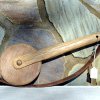Thanks Jim for sorting out my allotment rods!
Nice piece of history Dave. Must find time to go and have a look in the Guildhall. Having had a look around the internet it seems the inch and yard has changed many times in history while the metre has remained the same. The mind boggles.
Some seem to have taken the move from Imperial to Metric in their strides while others use Metric only when necessary. But how on earth did we ever learn all this stuff? Most of us were probably reared on the Imperial system alone, but we should think ourselves lucky. Today's 11-14 year olds have to get to grips with both systems right from the start. Viv.

Nice piece of history Dave. Must find time to go and have a look in the Guildhall. Having had a look around the internet it seems the inch and yard has changed many times in history while the metre has remained the same. The mind boggles.
Some seem to have taken the move from Imperial to Metric in their strides while others use Metric only when necessary. But how on earth did we ever learn all this stuff? Most of us were probably reared on the Imperial system alone, but we should think ourselves lucky. Today's 11-14 year olds have to get to grips with both systems right from the start. Viv.









